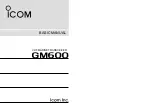
Page 91
FT
DX
9000MP O
PERATION
M
ANUAL
UUUUU
SING
SING
SING
SING
SING
THE
THE
THE
THE
THE
AAAAA
UT
UT
UT
UT
UTOMA
OMA
OMA
OMA
OMATIC
TIC
TIC
TIC
TIC
AAAAA
NTENN
NTENN
NTENN
NTENN
NTENNAAAAA
TTTTT
UNER
UNER
UNER
UNER
UNER
A
A
A
A
A
D
D
D
D
DVICE
VICE
VICE
VICE
VICE
The ATU is connected both to the transmitter and
the receiver, and its natural RF selectivity has a ben-
eficial effect in rejecting out-of-band energy dur-
ing reception. Accordingly, we recommend that the
ATU be left “On” at all times.
Q
Q
Q
Q
Q
UICK
UICK
UICK
UICK
UICK
P
P
P
P
P
OINT
OINT
OINT
OINT
OINT
As shipped from the factory, only one ATU
alignment point is saved on each Amateur band.
This was memorized during the final alignment
and performance verification stages on the pro-
duction line.
The momentary flickering of the [
TUNE
]
switch's LED occurs whenever you cross over
into a new 10 kHz ATU memory window.
A
BOUT
ATU O
PERATION
Figure 1 depicts a situation where normal tuning via the ATU has been successfully completed, and the tuning data has been
stored in the ATU memory. The antenna system as seen by the transmitter is shown.
In Figure 2, the operator has changed frequency, and the HI SWR LED has become illuminated. The operator presses and
holds in the [
TUNE
] switch for two seconds to begin impedance matching using the ATU.
If a high SWR conditions exists (above 3:1), corrective action must be taken in the antenna system to bring the impedance
closer to 50 Ohms. Besides the fact that the ATU will refuse to memorize settings on frequencies where the SWR exceeds
3:1, the high SWR may indicate a mechanical failure in the feed system, and such failures can lead to the generation of
spurious signals causing TVI, etc.
Figure 1
Figure 2
N
N
N
N
N
O
O
O
O
OTE
TE
TE
TE
TE
Although transmitter power is decreased to 200
Watts (maximum) during tuning, by all means
please check the operating frequency before begin-
ning the tuning process, to be sure you are not in-
terfering with others who may already be using the
frequency.
T
T
T
T
T
ERMINOL
ERMINOL
ERMINOL
ERMINOL
ERMINOLOGY
OGY
OGY
OGY
OGY
Antenna Tuner Memories
The microprocessor of the ATU makes a note of
the positions of the tuning capacitors and the se-
lected inductors, and stores the data for each 10
kHz window in which tuning has occurred. This
eliminates the need to re-tune every time you re-
turn to a frequency on which you already have com-
pleted the tuning process.
About ATU Memories
SWR (Post-tuning) Less than 1.5:1
The tuning settings are committed to the ATU memory.
SWR (Post-tuning) Greater than 1.5:1
Tuning data will not be retained in memory. If you return to the same frequency, the tuning process must be repeated.
SWR (Post-tuning) Greater than 3:1
The HI SWR LED will light up, and tuning settings, if achieved, will not be memorized. Please investigate and
resolve the high SWR condition before attempting further operation using this antenna. The high SWR may indicate
a mechanical failure in the feed system, and such failures can lead to the generation of spurious signals causing TVI,
etc.
SWR = 1.0
SWR = 1.5
SWR = 2.0
Ë
Frequency
SWR after ATU Tuning
Feed Point SWR
SWR = 1.0
SWR = 2.0
SWR = 3.0
①
②
Ë
Ë
Frequency
Memorized ATU Setting
Retuned Setting
Summary of Contents for FT DX 9000MP CONTEST - DATA MANAGEMENT OPERATION
Page 1: ...FTDX 9000MP Operation Manual...
Page 2: ......
Page 125: ...Page 123 FT DX 9000MP OPERATION MANUAL N N N N NO O O O OTE TE TE TE TE...
Page 171: ...Page 169 FT DX 9000MP OPERATION MANUAL N N N N NO O O O OTE TE TE TE TE...
Page 175: ...Page 173 FT DX 9000MP OPERATION MANUAL N N N N NO O O O OTE TE TE TE TE...
Page 178: ...Page 176 FT DX 9000MP OPERATION MANUAL N N N N NO O O O OTE TE TE TE TE...
















































